Syngonium: home care
Growing juicy stems at home does not require special skill, simple adherence to conditions and rules will help you achieve success. Five basic rules that will allow you to provide Syngonium flower care at home.
The first rule is illumination. Tropical vines love partial shade; direct rays are destructive. The right choice would be the premises located on the west, east, north sides. The more scattered light, the more variegated the color can be. For uniformly faded sheets, more shade is required.
The second rule is temperature. In summer, it is better for her not to exceed 24 degrees Celsius, in winter - 18 degrees. The minimum threshold is 10 degrees for a short time.
The third rule is humidity. The air around the plant should be humidified, in summer it is better to spray the leaves once a day, in winter to remove the pot away from the heaters. Soil moisture is provided by irrigation. It should be carried out when the topsoil dries up. The flower does not like stagnant water in the pan and excessive watering. It is better to use water at room temperature.
The fourth rule is soil. The optimal proportion - mixed in equal proportions of leaf and turf soil, sand, peat mixture
It is important to ensure good drainage from expanded clay or other sorbents. Florists add bone meal and activated carbon to pots
The fifth rule is feeding. Liquid mineral fertilizers will be useful in the warm season once every two to three weeks. In addition to vitamin supplements, pinching is done to vines for greater bushiness. Above the sixth to seventh leaf node, young shoots are carefully cut off with the arrival of spring.
Attention! When working with syngonium, it is important to use gloves, do not allow children, pets to come into contact with the juice from the vines. The flower has a certain level of toxicity, it can be dangerous
Reproduction
In order to propagate an evergreen vine, three methods are used:
- with the help of the upper parts of the shoot, when a stalk with 2-3 young leaves and a living bud of an aerial root is cut off from the stem;
- using a part of the stem with a living point of growth in the form of a kidney - in this case, any part of the stem along its entire length is suitable for planting, you only need to cut off the stalk with a bud of the required size;
- using aerial roots - part of the stem is used, on which aerial layers of roots have already formed.
Having prepared the planting material in one way or another, it is planted in a soil mixture consisting of peat, sand, turf, pine bark (or moss), taken in equal proportions. After planting, the cuttings are moistened, and the container where they are planted is covered with plastic wrap. Then, in order to root the plantings, they are placed in a warm and bright place. Every day, the film must be removed and the young seedlings must be ventilated.
In literally two weeks, young syngoniums will have roots (if you propagated them by cuttings), or, if these were cuttings with aerial roots that you planted in the soil, their rooting will occur. Now young plants can live without shelter under the film, developing independently and adapting to environmental conditions.
Syngonium can be propagated by cuttings or lateral shoots during the warm season. The material can be placed in water or in a light substrate for germination.
To speed up the rooting process, it is possible to use vermiculite. After root formation, the young plant is transplanted into a small container with good drainage and a suitable potting mix.
Syngonium can be easily and quickly multiplied.The simplest methods are cuttings and seed propagation. You can use the method of dividing the rhizome, but the roots of the plant are so thin and tightly entangled that they will certainly be damaged when dividing.
- For propagation by cuttings from syngonium, apical cuttings are taken, 13-15 cm long, while each stem should have 2-3 leaves.
- Cuttings root easily, both in water and in the substrate. You can use wet sand or sphagnum.
- The stalk is covered with a film to create a "greenhouse effect" and left in a warm place, periodically watering the soil.
- The plant will take root in 3-4 weeks.
- After which it can be transplanted into a pot or left to "gain strength."
What does it look like, which family it belongs to
The homeland of the plant is considered to be South America. Syngonium is a bright representative of the numerous aroid family, numbering more than 30 species. In Latin, the name is consonant - Syngonium.

Tropical guest of city apartments syngonium
The appearance of the plant is an evergreen vine with a flexible green stem, on which multiple air roots are located. Vine houses grow up to one and a half to two meters, dotted with lush foliage on long cuttings.
Foliage can be of various shades of green: from whitish to rich; there are variegated colors: spotted, shaded, sinewy.

The flower can be not only green, there are individuals with pink leaves.
Note! Color saturation is determined by the light level of the room. The brighter the diffused light, the darker the color
Indoor syngonium blooms extremely rarely, but if this happens, the plant will delight with an ear surrounded by a light green blanket, which will turn slightly red over time.
Those wishing to grow syngonium are interested in whether it is possible to keep an unusual plant at home, and what atmosphere the flower creates in the house.
A tropical guest is believed to have a positive energy and is able to have a healing effect. A flower is useful when surrounded by people suffering from gastrointestinal disorders.
Signs attribute to the syngonium the ability to change life for the better - this is due to a change in the growth process. Therefore, it is advised to start it at home for people living in the past.
The third belief is associated with the ability to get rid of unpleasant dreams, keep a pot of vines well in the bedroom.
Syngonium brief information
Syngonium is an unusual variety of picturesque, bright, unpretentious herbaceous vines and semi-epiphytic plants in which flexible stems do not branch. And this miracle adjoins the genus of more than thirty evergreen, perennial, fast-growing flowering monocotyledonous plants in the Araceae family.
The syngonium plant is native to the rainforests of the Center and South of the northern part of the American continent. Several varieties are found in the West Indies.
A literal translation from the Latin language of the genus name syngonium ("syn" and "gone") will mean a united ovule. This determines the specific course of plant development in virgin nature.
The houseplant syngonium is a herbaceous plant that has a thin stem with airy roots that try to grab onto a support. The shape of the syngonium leaves is varied. The leaves of young lianas can be whole, lobed, deeply dissected. They are similar to an arrow, a heart, a spear, and as the plant grows older, dissected three or five segmented lobed leaves can grow on it. And the variety of colors varies from green to completely white with variegated specks, strokes and silvery veins.
Unusual axillary inflorescences of the signonium have the form of an ear, always in an upright position. They are located on a semi-cylindrical or triangular short pedicel, which grows with the ripening of fruits containing about a hundred fragrant brown seeds.
The cultivated syngonium flower never blooms, and in tropical forests this beautiful plant forms a green cob-type inflorescence with a reddish or pink bracts in the form of a membranous bedspread.
Syngonium has taken root ideally in the home. Many consider it a symbol of prosperity and peace. Fuchsia can make a wonderful company to this phyto handsome man. Together with an elegant and beautiful syngonium, they will decorate the interior of any production facility or apartment.
The graceful handsome syngonium is very close in structure and resembles a more powerful and solid philodendron.
Syngonium species and varieties
Signonium auricular, the second name is syngonium auritum (Syngonium auritum)
The ear-shaped type is a type of climbing lianas with long stems, the thickness of which is 2-2.5 cm. Aerial roots are formed in the internodes. Signonium can grow up to two meters, and the annual growth is about 80 cm.
Green, glossy, resilient foliage up to thirty-five centimeters long and twenty centimeters wide, changing with the age of the plant, resembles drooping ears. Beautiful bright leaves are located on 40-centimeter petioles.
Syngonium podophyllum or podophyllum (Syngonium podophyllum)
The leg-leaved syngonium is a handsome man with dark green leaves. At the beginning of development, the leaves are arrow-shaped, and with age they become stop-shaped and dissected into from five to eleven elliptical segments, the dimensions of which reach 30 cm in length and ten centimeters in width. And they flaunt on half-meter petioles with ten centimeter bedspreads.
Syngonium Pixie
Syngonium Aron Broun
Syngonium Neon Pink
Botanical description
The Aroid family, to which the syngonium belongs, has 3300 species and approximately 117 genera. Representatives of this family are monocotyledons. This means that the embryo consists of one lobe. Since this plant grows on other specimens of flora, it belongs to the class of epiphytes.

Syngonium belongs to the Aroid family
For your information! The plant envelops the tree trunks for support, to be closer to the sun. In the forest thicket, the flower does not have enough light.
Wild and indoor plants have only one trunk. Syngonium has a flexible stem, which is colored bright green. The plant spreads on the ground and grasps the support with aerial roots. Shoots can reach a length of 1.5-2 m.Under natural conditions, some vines grow up to 10-20 m in length, and 6 cm in thickness.In indoor plants, the stem is usually 1-2 cm thick. leaves. Aerial roots are below the nodes. These roots are needed to cling to the support.
The leaves are bright green. The heart-shaped part of the leaf is divided into 3-5 segments. There are veins in the center and along the edge, which distinguishes the syngonium from other Aroid species. The side veins connect to the center vein to create a mesh pattern.
For your information! The surface of the leaf plate can be monochromatic or variegated, as well as leathery or velvety.
It is quite easy to keep syngonium at home. So that there are no questions about why the vine is not growing, it is worth following a few simple requirements:
- water abundantly with clean, settled warm water. However, it is worth waiting for the time between waterings so that the top layer dries out a little. In winter, the plant is watered in smaller volumes;
- observe high air humidity. For this, the leaves are sprayed with settled warm water. In winter, the pot where the liana grows can be placed in a container with damp pebbles;
- before pinching the plant, you need to think about in advance what shape you want to get the flower. You can choose a bush option or make a support and get a vine. In spring, it is necessary to remove bad growth so that there are more branches.For this, pinching is carried out over the sixth sheet;
- the liana is transplanted in the spring. Young plants are transplanted every year, and those that are older, after two years, when the roots become visible from the drain holes;
- the soil should be loose and neutral in acidity. In equal parts sand, leaf and sod land, as well as peat are mixed;
- from April to September, the flower is fertilized with mineral fertilizers, which contain a small amount of calcium. Top dressing is carried out once every 20 days. You cannot fertilize the plant for two weeks after transplanting;
- reproduction is carried out by cuttings. To do this, cut off the top with two nodes and a shoot with a bud. Seedlings are kept in a warm place under glass. After rooting, it can be transplanted.
Syngonium wendlandii
The most popular type of syngonium leg-leaved (S. podophyllum) with a thin climbing stem. Young leaves are simple, pointed, arrow-shaped. In adult plants, the leaves become dissected to the base, heart-shaped, sitting on long cuttings. With age, the color of the leaves also changes - instead of bright green juicy, they become silvery with dark veins. This type of syngonium became a beginner in the development of subsequent varieties.
Syngoniums are grown as an ampelous (hanging from a hanging vase), climbing (on a lattice or any support), bushy plant. Unlike lianas, there are compact bush varieties with small leaves.
Most often on sale there are varieties of syngonium with variegated leaf color: "Green Gold" - with dark green veins on a light background, "Imperial White" less often, although its leaves are more exotic in shape; White Butterfly and others ... The garden form looks like a bright mosaic.
Description of syngonium
In representatives of the genus, the stem is elongated, herbaceous, ascending or creeping with a sympodial type of growth, reaching a length of 10-20 meters. The shoot is unbranched, but when the apical meristem is damaged or pruned, it begins to branch.
Aerial roots develop along the stem, the function of which is to supply the plant with nutrients and to cling to the support. Roots take root easily upon contact with soil. If the top of the stem loses contact with the support, the plant begins to produce longer internodes and smaller leaves.
The main decoration of the syngonium liana is its leaves - in nature they are uniformly green, but in home culture you can find varieties with variegated foliage painted in white, cream, pink, bronze, light green or golden hue.

Young (juvenile) leaves are whole, ovate or elliptical, the shape of mature leaves is ovate-elliptical, oblong-ovate or sagittal. Each year, 5-7 new leaves can be expected to grow.
The inflorescence is a rather large ear, surrounded by a petal-veil. Unfortunately, at home, the flowering of syngonium can be seen extremely rarely.
Despite the toxicity, albeit small, syngonium can be kept at home, only it is better to set the pot away from pets and be more careful or use gloves when caring for it.
3.Species:
3.1. Syngonium leg-leaved - Syngonium podophyllum
Interesting decorative deciduous plants that have leaves of different shapes. Only the young leaves that have appeared are heart-shaped, and as they grow older, they stretch out and acquire a rather spear-shaped shape. On a dark green background of leaf blades, this species has a silvery - white or creamy coating. Liana has long flexible stems that can reach 180 cm in length. During the flowering period, the plants form tiny greenish flowers, collected in an inflorescence of the cob. The ears are surrounded by a pale green blanket.

3.2 Syngonium Imperial White
A variety of leg-leaved syngonium with large front leaves on long petioles.The color of the leaf plates is peculiar - on the main green background there are scattered various sizes of spots and specks of white. The leaf blades are glossy.
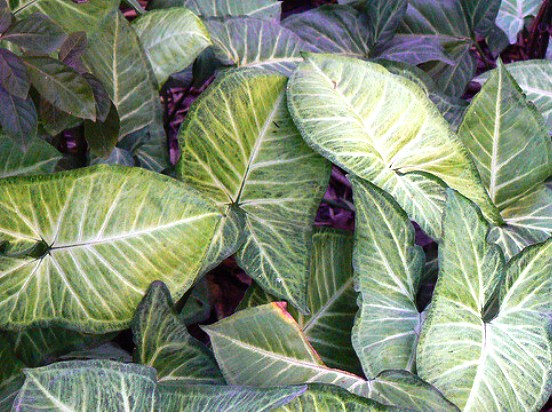
3.3 Syngonium Wendlandii
Colorful decorative deciduous plants with dark green narrow spear-shaped leaves. The color of the leaves can include several shades of green. A characteristic feature of the sport is the presence of a white center on the leaves with radiating rays along the veins.
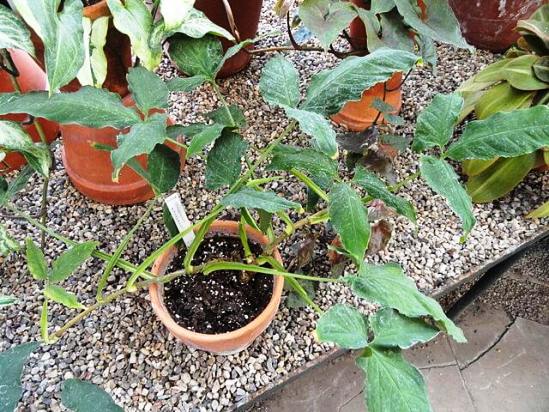
3.4 Syngonium Neon Pink
A very effective decorative - deciduous plant - liana. An interesting feature of the sport is that young leaves have a gentle green tint, while adult leaves are painted in a pale pink color. The leaf blades are glossy, spear-shaped; the veins are branched, slightly recessed into the leaf plates.
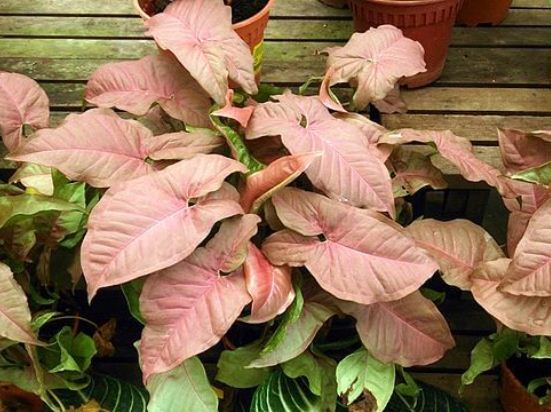
3.5 Syngonium Pixie
A compact type of syngonium, which often does not exceed 15 cm in height. The plant has small, green, heart-shaped leaves. The center of the leaf plates is colored in a lighter shade.
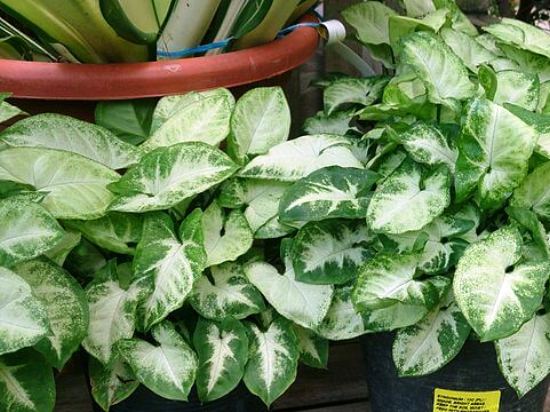
3.6 Syngonium Butterfly
Plants with large spear-shaped leaves. Young leaves have a dark green tint, with pronounced light streaks. There are plants with white or yellow veins. With age, the leaves of plants fade more and more and often retain a green tint only at the edges of the leaf plates.
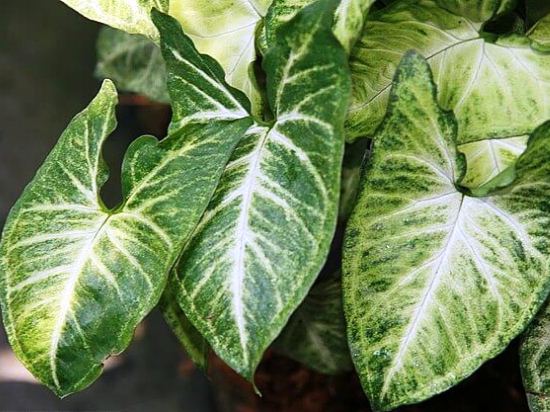
3.7 Syngonium Tiffany
Ornamental-leaved plant with small heart-shaped leaves. The leaf blades are glossy, green. In the center of the leaf plate, closer to the central vein, there are pink or yellowish spots.

3.8. Syngonium Macrophyllum or large-leaved - Syngonium macrophyllum
One of the most common species in indoor culture. The plant has large, emerald green, heart-shaped leaves on long petioles. The surface of the sheet plates is glossy. There are plants with a white or yellowish bloom on the leaf blades. During the flowering period, the syngonium throws out a pink inflorescence - an ear, surrounded by a pink veil.

3.9. Syngonium Brocante
Decorative-deciduous liana is a variety of leg-leaved syngonium with glossy spear-shaped leaves. Young leaves are colored brown or burgundy; with age, the leaf plates become more and more green, glossy.
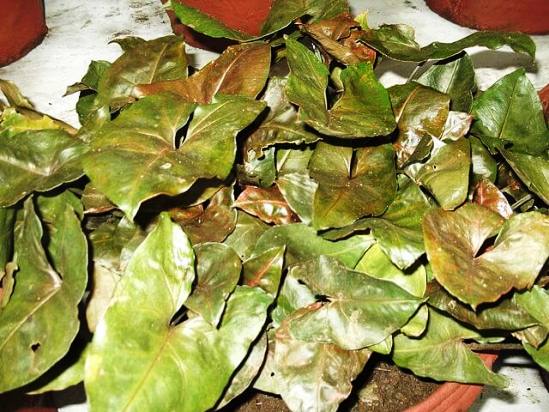
You may also be interested in:
Aglaonema
Epipremnum
Philodendron
Zamioculcas
Syngonium - plant description
While his relatives are increasingly occupying the counters of flower shops and the pages of glossy magazines, the syngoniums have lost their former glory. And completely undeserved. One of the most graceful indoor lianas surprises with variegated leaves, and the choice of varieties with different colors, and visual grace, and longevity.
It requires conditions that not everyone can recreate, but if the collection already contains moisture-loving crops, syngonium is one of the best candidates for replenishing the collection.
Syngoniums rarely attract admiring attention immediately, but still it is very difficult to call them boring
In nature, syngoniums are true Americans. They are found in large numbers in rainforests around the planet, but they can boast the greatest diversity in South and Central America.
Among the Aroid family (Araceae) there are many spectacular vines, and the syngonium is one of the most modest, but non-standard. This is one of the largest epiphytic indoor lianas. "Starting" from a modest 40-60 cm, syngoniums resemble huge bunches or a tangled mass of leaves sitting on very long petioles, under which thin stems are almost invisible.
With age, syngoniums transform into large enough plants capable of exceeding 2 m in height.
Shoots are thin, non-branching, flexible, aerial roots are almost invisible at a young age and become an important part of the appearance when mature. They grow from internodes, often almost merging with the petioles and are distinguishable only close
Syngoniums are one of the fastest growing vines. In comfortable conditions, they can add up to 80 cm in length per year, remaining compact only for the first few years. Moreover, the older the syngoniums, the faster they grow.
In indoor conditions, during the formation of a liana, it is most often limited to 1-1.5 m. Elongated internodes emphasize the beauty of long-petiolized leaves and give the plant a visual lightness. The petioles can be up to half a meter. Thin, flexible, often dark, leaf stalks are no less a decoration of a plant than the greenery itself. They bend, create a sense of lace tangled, allow this vine to remain airy and elegant no matter the size.
Two types of leaves on one vine
One of the unique features of the sinuous and evasive nature of the syngonium is the presence of two types of leaves and a significant change in appearance with age. The leaves of young plants are simple, but with age the syngoniums begin to produce completely different, palmate-complex leaf blades.
Oval-lanceolate leaves of young bushes in shape most resemble an arrowhead. When blooming, they are reddish, but quickly lose their bright shade. But young, lighter, up to 15 cm long leaves are quickly transformed.
Old sheets will divide into fancy lobes, conquer with a plate cut into "fingers", grow more and more, flaunting flawless lobes. The veins, highlighted with a light color, with a dark petiole of leaves only emphasize the unusualness of the plant, folding into beautiful patterns.
The stripes along the veins are asymmetrical and loose, resemble drops and splashes, and can be either warm creamy or silvery, light green or white.
Syngonium bloom
The flowering of syngoniums seems somewhat strange on such a vine. It is a rare pleasure to enjoy it in a room format. Meanwhile, exotic green "calla lilies" look very attractive.
Thick cobs are hidden under a blanket up to 10 cm in length, the inner surface of which is painted in a bright red shade, unexpectedly expressive for the light green outer color.
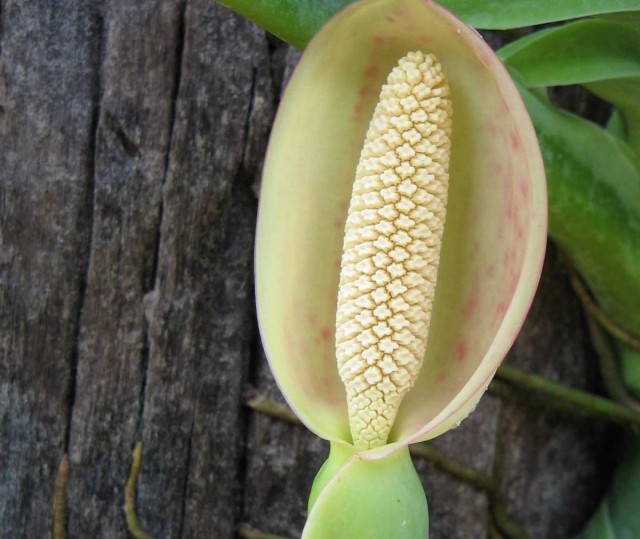 Blooming syngoniums indoors is an almost inaccessible luxury. Garden ideas
Blooming syngoniums indoors is an almost inaccessible luxury. Garden ideas
Diseases and pests
With improper care or inappropriate growing conditions, syngonium can be exposed to a number of diseases that spoil its decorative appearance and can even lead to the death of the plant. Most often, flower growers are faced with the following problems:
- Syngonium leaves turn yellow - there is not enough minerals, too poor soil or too much light.
- Brown spots appear on the leaves of the syngonium - the air in the room is too dry. The plant recovers with regular spraying and regulation of the humidity level in the room.
- The stems rot - the reason may be frequent watering and insufficiently drying substrate. The irrigation regime should be reviewed.
- Stems are stretched - poor lighting and shoots are drawn to the light. The same problem can arise when the plant becomes cramped in the pot, and its roots completely fill the earthen ball.
- Drops on the tips of syngonium leaves - in this way the vine fights excess moisture in the soil and in the air.
Variegated species of syngonium are especially sensitive to light levels. If it is insufficient, then the leaves become faded, pale and lose their luster.
Liana can be attacked by harmful insects, scale insects, whiteflies, spider mites, mealybugs. If pests are found, the plant should be treated with an insecticide, and in advanced cases, remove from the pot, rinse the roots with a weak solution of manganese and replace the soil.
Syngonium is not very susceptible to pests, but in the case of acquiring an already infected liana, harmful insects rapidly spread throughout all indoor plants.
| Fitoverm; | Aktara; | Actellic. |
Among the diseases, syngonium is most often affected by such ailments:
- powdery mildew;
- rot is gray;
- late blight.
After treatments, it is recommended to transplant the plant into new soil, and cut off and destroy all affected leaf plates.
Diseases, pests and problems in growing syngonium
This vine, with normal care and maintaining an average humidity of the air, is almost invulnerable. But if syngoniums suffer from pollution, grow in a dry environment, then pests quickly spread through them.
Aphids, scale insects and thrips adore this plant and can be difficult to deal with, even with strong insecticides. Immediate isolation of the syngoniums, correcting conditions and starting the fight at the earliest possible stage of defeat is the best strategy.
Syngoniums, as a rule, themselves indicate insufficient care. Uncomfortable lighting changes the color of the leaves, insufficient or excessive feeding leads to their paleness or yellowing. Any spots or dry areas on the leaves appear only when the air humidity is low. And if the humidity is too high, droplets of water appear on the leaves, sometimes heralding heavy rainfall, sometimes in gratitude for the right environment. This signal is rather positive. And no action is required.
Pruning
There are several ways to form a crown. The easiest way is to hang the pot with the plant in the pots as high as possible, then the stems will grow up to almost two meters in length and hang beautifully to the floor. There are tricks for vertical planning.
A moss tube can act as a support for the vine. With the next transplant, it goes deeper into the center of the pot at the stage of laying the drainage. After the first third of the soil is filled up, the plant is transferred, the soil is filled up around the circumference. Over time, the stems will twist around the resulting support, creating a decorative appearance of the flower.
You can make a bushy plant from a climbing plant by forming a crown. Cutting off shoots at the level of the sixth leaf leads to the formation of lateral shoots, for which the procedure can be repeated. Thus, a compact bush for small spaces is formed.


